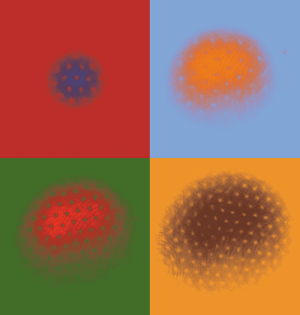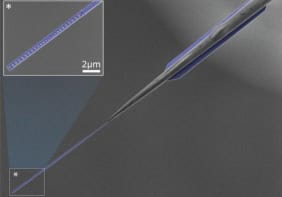Research into the exotic quantum phenomenon of Bose-Einstein condensation shows no sign of slowing as researchers in the US and France make advances in different directions.

Almost six years have passed since the first Bose-Einstein condensates were created in dilute atomic gases. In that time the field has blossomed into one of the largest and most active areas of atomic physics. Recent months, in particular, have witnessed a rapid growth in research into Bose condensates, with the announcement of breakthroughs in three very different areas.
First, Alain Aspect and Chris Westbrook’s group at the Institut d’Optique in Orsay and, independently, Claude Cohen-Tannoudji, Michele Leduc and co-workers at the Ecole Normale Supérieure (ENS) in Paris have achieved Bose-Einstein condensation in metastable helium (A Robert et al. 2001 Science 292 461; F Pereira Dos Santos et al. 2001 Phys. Rev. Lett. 86 3459). Second, Wolfgang Ketterle and co-workers at the Massachusetts Institute of Technology in the US have observed the formation of an array of up to 130 vortices within a large condensate (J R Abo-Shaeer et al. 2001 Science at press). And finally, Mark Kasevich’s group at Yale University, also in the US, has conducted the first experiment in quantum atom optics by creating a so-called squeezed state in a rubidium condensate (C Orzel et al. 2001 Science 291 2386).
All four of these latest experiments begin by cooling the atoms to temperatures below 1 mK with laser radiation and then loading them into a magnetic trap. Evaporation of the most energetic particles from the trap cools the remaining cloud of atoms further to the Bose-Einstein phase transition. At this point the atoms suddenly accumulate in the lowest energy level of the system (see Physics World August 1999 pp37-42).
Bose-Einstein condensates have unusual properties because almost all the atoms in the condensate are in the same quantum ground state and can therefore be described by the same wavefunction. This makes it possible to calculate many of the properties of Bose condensates from first principles.
Metastable helium
Most experimental groups have focused on creating condensates in alkali-metal vapours, such as lithium, sodium and rubidium, and even in atomic hydrogen. The phenomenon of Bose-Einstein condensation is also closely related to superfluidity in liquid helium-4, and is responsible for the ability of superfluid helium-4 to flow without resistance. However, many of the processes in liquid helium are too complex to allow the underlying physics to be unravelled. Bose-condensed gases, in contrast, are much simpler systems.
The groups at Orsay and the ENS have been laser cooling atoms in excited electronic states for many years, so why has it taken so long to get the atoms to condense? The reason is that each metastable helium atom contains about 20 electron-volts of energy that is just waiting to be released in collisions, making the atoms more like unexploded mines than billiard balls. Thus cooling the atoms to microkelvin temperatures – where their thermal energy corresponds to only 10-10 electron-volts – requires delicate handling.
Aspect and co-workers – and later the ENS group – overcame this problem by confining some 200 million excited helium atoms in a magnetic trap to align the “spins” of the atoms (that is their intrinsic angular momentum) in the same direction. This polarization suppresses the inelastic collisions that release the internal energy of the atoms. Amazingly, the polarization curbs the collisions long enough for a condensate to form for a few seconds.
The Orsay group exploited the energy that is released as the helium atoms impact on a surface to detect them. The technique, which is similar to ion counting, can resolve the position of individual atoms to within a few nanometres. What is more, it will enable measurements on condensates containing smaller numbers of atoms than the clouds of alkali gases. This extension of Bose condensation to rare gases opens many exciting new possibilities, particularly in atom optics.
An array of vortices
Superfluids do not rotate like rigid bodies. So-called rotating-bucket experiments with liquid helium-4 have demonstrated that the rotation of the container leads to the creation of vortices, rather than bulk motion of the liquid (see Physics World February 1997 pp25-30, print version).
In some ways, however, the superfluid mimics the behaviour of a classical rotating object. The angular momentum of a rigid body, for example, is given by the product of its moment of inertia and the angular frequency of rotation. Similarly, the angular frequency sets an upper limit on the angular momentum of a superfluid. Simply speaking, this means that it limits the number of vortices that can be formed, because each vortex has one unit of angular momentum.
The number of vortices created by Ketterle’s group has almost reached this limit. The 130 vortices form a regular triangular array – the lowest energy arrangement – in a condensate consisting of 50 million sodium atoms (figure 1).
Smaller arrays of vortices in Bose-Einstein condensates have previously been created by Jean Dalibard’s group at the ENS, while Eric Cornell and co-workers at the JILA laboratory in Colorado have observed single vortices and vortex rings.
Like the ENS group, Ketterle and co-workers use laser beams to create a rotating distortion on top of the cylindrically symmetric magnetic potential that confines the atoms. This distortion imparts angular momentum to the condensate through a resonant mechanism that has been studied extensively in Paris. The MIT group was pleasantly surprised to find that the vortex array survived for several seconds – much longer than theoretically predicted. This will enable future studies of the mutual interactions of vortices of dilute Bose gases.
Squeezed states
The difference between a Bose-Einstein condensate and a thermal gas of atoms is similar to the difference between laser radiation and the photons emitted randomly from an ordinary lamp. The macroscopic occupation of the ground state of the system in a condensate – and of a particular cavity mode in a laser – leads to a high degree of coherence. Now Kasevich’s group at Yale has pushed the analogy between coherent light and Bose condensates even further by creating so-called squeezed states for atoms.
In general, a laser beam behaves like a classical electromagnetic wave. However, manipulation by nonlinear optics can put the light into quantum states known as squeezed states that have unusual properties. Usually, any measurement that records the arrival of N photons has a standard deviation of N1/2, but squeezed states allow the fluctuations in the measurement to be less than this so-called shot-noise limit.
Kasevich and co-workers created squeezed states for atoms by first making a small Bose condensate consisting of some 10 000 rubidium atoms. Next they slowly turned on a standing wave of light that passed through the centre of the condensate to give a corrugated optical potential (see figure 2). In this adiabatic process the atoms remain in the lowest energy level at the bottoms of the potential wells. The result is a line of 12 mini condensates, each separated by half a wavelength of light. Normally, the number of atoms, N, in each well has a standard deviation of N1/2 – just like photons. So how did the Yale team deduce that they could make the fluctuations smaller than this limit?
Quantum measurements obey the uncertainty principle, which dictates that two conjugate variables – such as position and momentum – cannot both be known precisely at the same time. Mathematically, this means that the product of the standard deviations in these two variables must always be greater than the quantum limit. Reducing or “squeezing” the standard deviation of one variable leads to greater fluctuations in the other.
In the Yale experiment the conjugate variables are the number of atoms in each well and the phase of the wavefunctions. To see the phase fluctuations, Kasevich and co-workers switched off the confining potential so that the separate mini condensates expanded and overlapped with each other. Interference between these matter-waves leads to two distinct peaks in the spatial distribution (figure 2b).
The team found that squeezing the number of atoms increased the fluctuations by deepening the potential wells in the relative phase between the mini condensates, thus washing out the interference pattern (figure 2d). They also plotted the degree of squeezing as a function of the amount of tunnelling between the 12 potential wells to demonstrate convincingly that the loss of contrast does not arise from external perturbations. In the future, squeezed states will be used to reduce the noise in precise measurements with matter-wave interferometers.
All of these beautiful results are the fruits of a great deal of experimental effort, and illustrate the diversity within this rapidly expanding field. There is little doubt that experiments with ultracold atoms are as hot as ever.




